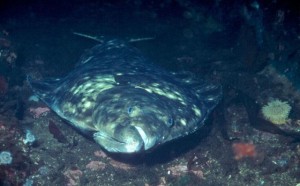Halibut harvests have been on the decline in the Bering Sea for years, but the amount that trawlers and catcher-processors are allowed to take has stayed the same. Now, federal regulators have agreed to consider stiffer limits on halibut bycatch.
This weekend, the North Pacific Fishery Management Council voted to study the impact of cutting the 10 million-pound bycatch limit by as much as 50 percent.
“Unless we act — and act fairly decisively — as soon as possible, we may continue to face what could be an emergency in a subsequent year,” Council member Duncan Fields, who introduced the measure, said.

Halibut fishermen narrowly avoided a major cut to their catch limit in the Bering Sea this winter.
The International Pacific Halibut Commission, which sets those limits, decided not to go through with the reductions as long as their counterparts on the North Pacific council agreed to take a second look at bycatch restrictions.
They’re written into federal policy. The council has the power to make changes and they have requested voluntary reductions across the fleet.
But as Karen Pletnikoff pointed out in public testimony, the cap hasn’t officially changed in over a decade.
“In that time, how many fish, jobs, and dollars would the Bering Strait, the Gulf of Alaska, Southeast and beyond have had and could have if that bycatch survived to recruitment?” she said.
Pletnikoff is a manager for the Aleutian Pribilof Islands Association. She pointed to shore plants in Atka and St. Paul that rely on deliveries of halibut to keep business going — and stand to benefit if there’s less bycatch and bigger harvests.
But representatives from the trawl fleet warned that tighter limits could create an economic burden on their side, as well.
The exact impacts aren’t clear yet. A draft study provided to the council showed that a 35-percent cut could cost one group of catcher-processors up to $368 million — mostly from fishing less to avoid halibut.
On that front, Captain John Nelson said he’s not sure how much more he could do. His vessel, the Rebecca Irene, has already changed its fishing schedule and added excluder nets to let halibut out.
“And we’ve been working with these tools a long time,” Nelson said. “The excluder really has been dialed in to be about as efficient as it can be, right up to this year. Beyond this point, I do not see, in my experience, a lot of gain. Any increments of gain — which we will continue to try to make — are going to be very small.”
Nelson said he did see promise in new tools like deck sorting. Instead of going inside the vessel to be weighed and tallied, halibut bycatch is checked right on deck and thrown back if it’s viable.
A few boats got permission to test that method under an experimental permit over the next year.
Until then, the North Pacific council has pledged to work with the international halibut board — and figure out better tools for estimating stocks and bycatch between the two of them.
The reductions will come back for review during the North Pacific council’s June meeting in Sitka. They’re scheduled to take final action at that time.




